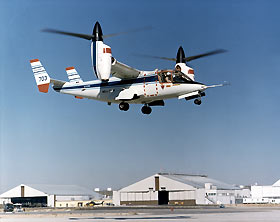
Enregistrez gratuitement cette image
en 800 pixels pour usage maquette
(click droit, Enregistrer l'image sous...)
|
|
Réf : S05182
Thème :
Aviation - Avions NASA-Prototypes (1538 images)
Titre : XV-15 tilt rotor takeoff - first NASA Dryden flight
Description : (La description de cette image n'existe qu'en anglais)
This photo shows the 1st XV-15 tilt rotor flight for NASA/Dryden at the Army contingent at Edwards Air Force Base, Edwards, California, October 1980. The former XB-70 hangar can be seen to the lower right. The two smaller cutouts on each side of the tail section slot were extra modifications for the large twin-tailed plane.The Bell XV-15 Tiltrotor aircraft were involved in limited research at the Hugh L. Dryden Flight Research Center in 1980 and 1981. The development of the XV-15 Tiltrotor research aircraft was initiated in 1973 with joint Army/NASA funding as a ''proof of concept'', or ''technology demonstrator'' program, with two aircraft being built by Bell Helicopter Textron (BHT) in 1977. NASA Ames Research Center, where most of the NASA research is conducted, continues to be in charge of the joint NASA/Army/Bell program. The aircraft are powered by twin Lycoming T-53 turboshaft engines that are connected by a cross-shaft and drive three-bladed, 25 ft diameter metal rotors (the size extensively tested in a wind tunnel). The engines and main transmissions are located in wingtip nacelles to minimize the operational loads on the cross-shaft system and, with the rotors, tilt as a single unit.For takeoff, the proprotors and their engines are used in the straight-up position where the thrust is directed downward. The XV-15 then climbs vertically into the air like a helicopter. In this VTOL mode, the vehicle can lift off and hover for approximately one hour.Once off the ground, the XV-15 has the ability to fly in one of two different modes. It can fly as a helicopter, in the partially converted airplane mode. The XV-15 can also then convert from the helicopter mode to the airplane mode. This is accomplished by continuous rotation of the proprotors from the helicopter rotor position to the conventional airplane propeller position. During the ten to fifteen second conversion period, the aircraft speed increases and lift is transferred from the rotors to the wing. To land, the proprotors are rotated up to the helicopter rotor position and flown as a helicopter to a vertical landing.
|
|

